Actinic Keratosis

Actinic keratoseis are precancerous skin growths due to excess sun exposure. These growths are also called solar keratosis. The growths look like dry crusty patches that are slightly raised. They may be red, tan, flesh-toned, or pink.
You can develop these growths anywhere you get excess ultraviolet light sun exposure or manmade sources like tanning salons. People most commonly get them on the scalp, ears, neck, face, lips, and shoulders. The forearms and back of the hands are other locations where actinic keratosis often appears.
Actinic keratosis can turn into squamous cell carcinoma, a type of skin cancer. If you develop these growths, see your dermatologist. They are treatable with a topical cream or the doctor may remove them surgically or freeze or burn them off.
Seborrheic Keratosis
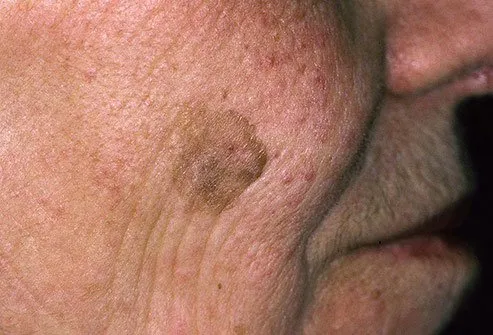
One of the skin changes with age includes the appearance of seborrheic keratoses. These benign growths are tan, brown, or black and tend to appear on the chest, head, back, and chest. Some people describe their appearance as waxy and raised. Seborrheic keratosis are more common in people over the age of 50 and they tend to run in families.
If you're prone to developing these growths, you're likely to get multiple ones. They're not dangerous, but they may be unsightly or bother you. If they do, see the dermatologist to have them removed. A dermatologist can tell whether a growth is a seborrheic keratosis or something more serious like skin cancer. If they aren't sure, they can take a biopsy for confirmation.
Liver Spots
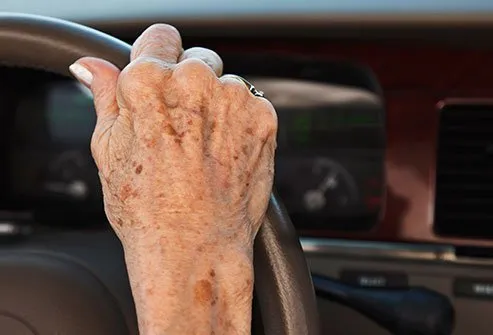
Do you have liver spots on sun-exposed areas of your skin? If so, you're not alone. Liver spots, or age spots, are common over the age of 50 although some people get them earlier. Another name for these spots is solar lentigines. The spots are brown, black, or tan. They occur most commonly on your hands, arms, face, and shoulders.
Liver spots aren't dangerous, but you might not like the way they look. Your doctor or dermatologist can recommend bleaching treatments, laser therapy, or chemical peels to reduce the appearance of liver spots. There are also over-the-counter lightening creams you can try first.
Liver spots are preventable. Stay out of the sun and wear sunscreen when you do go outside. How do you tell the difference between skin cancer vs age spots? See your dermatologist who will do a biopsy if they suspect a spot is skin cancer.
Cherry Angioma
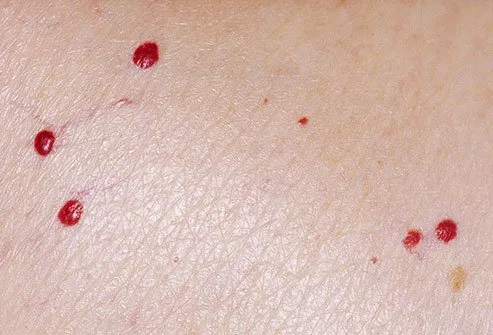
Cherry angiomas are benign red growths that occur due to proliferating cells found inside the lining of blood vessels (endothelial cells). They occur most commonly in people over the age of 40. Cherry angiomas tend to run in families. You can get them anywhere, but the face, scalp, trunk, and lips are the most common areas where these occur.
Cherry angiomas are benign, but they may resemble other skin conditions that are benign or cancerous. See your dermatologist who can diagnose skin growths. You don't need to remove cherry angiomas, but if they bother you, the doctor can remove them with cryotherapy (freezing), laser therapy, or electrosurgery (burning).
Skin Tags

Skin tags are benign skin growths that resemble tiny flaps on a stalk and are very common. Approximately half of all adults have at least one. They are more common in those who suffer from diabetes or obesity and tend to run in families.
Skin tags occur where there are skin folds, such as the neck, armpits, eyelids, and groin. They aren't dangerous, but they can become irritated when they rub against clothing. If the skin growths bother you, see your dermatologist who can remove them surgically or freeze, burn, or laser them off.
Solar Elastosis
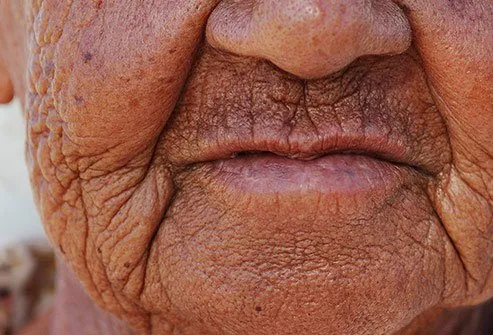
Excess sun exposure over long periods of time can cause physical changes in the elastic fibers of the skin, leading to a condition called solar elastosis. This causes deep wrinkles, ridges, and bumps in the skin and it causes the skin to have a yellowish appearance. Anyone can get solar elastosis, but it's more obvious in those who are fair-skinned.
Smoking damages skin in a similar way leading to solar elastosis. The combination of long-term sun exposure and smoking wreaks havoc on the skin. The best skin care and anti-aging routine involves staying out of the sun and wearing sunscreen when you are outdoors. And protect your health and skin by not smoking.
See your dermatologist for solar elastosis treatments, which may include laser therapy, fillers, Botox injections, and other approaches.
Varicose Veins
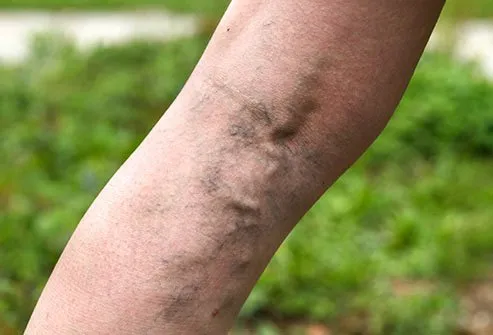
Varicose veins are enlarged veins that may look twisted. They bulge out of the skin. High blood pressure causes varicose veins that most commonly appear on the legs and feet. Factors that increase the risk of varicose veins include excess weight, pregnancy, female gender, inactivity, older age, smoking, leg injury, hormone replacement, or being on oral contraceptives.
Varicose veins may cause you pain or lead to sores, skin color changes, or a rash. If they bother you, you can try things like elevating your legs above heart level 3 to 4 times a day for 15 minutes every time. A doctor may recommend that you wear compression stockings. If you're still having problems after trying these measures, your doctor may recommend injecting the troublesome veins (sclerotherapy), thermal ablation, or surgery to remove them.
Spider Veins

Spider veins are less serious versions of varicose veins. They are smaller and have a spider web like appearance. Spider veins often appears on the legs, face, feet, and ankles. They are superficial and lie just underneath the surface of the skin.
The reddish and bluish spider veins may cause burning, itching, or other discomfort. As in the case with varicose veins, you can try wearing compression stockings and elevating your legs to see if that helps relieve your symptoms. If not, see your doctor to discuss your options for treatment.
Itchy Skin

Oil glands produce less oil as people age. This results in itchy skin. Things like stress, smoking, dehydration, excess sun exposure, and dry air can make the problem worse. Slather on moisturizer to soothe dry skin and drink plenty of water to stay hydrated. Bathe less often and use mild skin cleanser instead of soap. Using a humidifier may help your skin feel hydrated and relieve itching. Steer clear of perfume, which may cause itching, too.
If you have itching all over or if you suffer from itching for more than a couple of weeks, see your doctor. Itching may be a sign of something more serious like kidney disease, diabetes, anemia, liver issues, or thyroid trouble.
Leg Ulcers
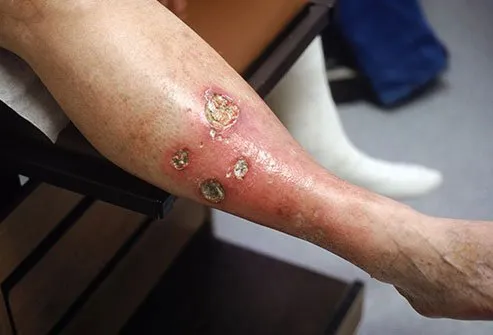
Do you have leg sores that ooze? Don't ignore them. Open wounds may become infected with bacteria and lead to bigger health issues. Conditions that increase the risk of leg ulcers include diabetes, varicose veins, smoking, pregnancy, and obesity, to name a few. See your doctor if you get a leg ulcer. They may refer you to a wound care clinic.
The treatment for a leg ulcer depends on the patient's age, overall health, and the underlying cause of the ulcer. Generally, you need to keep the wound clean and elevated. It's important to move to keep the blood flowing. The doctor may recommend putting pressure on the region, such as by wearing compression stockings. Some people with leg ulcers need surgery.
Contact Dermatitis
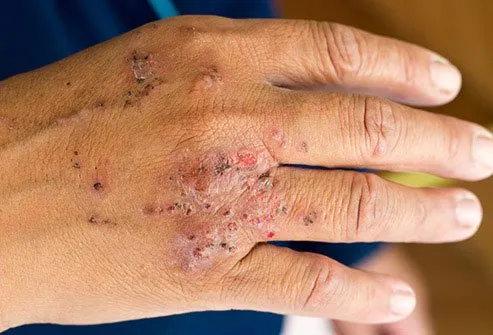
Contact dermatitis is a red, itchy, painful rash that results when you come into contact with a substance that is allergic or irritating to the skin. There are two forms of contact dermatitis – allergic and irritant.
Irritant contact dermatitis is the more common form. The rash comes on when you come into contact with certain plants, shampoos, rubbing alcohol, bleach, detergents, and other substances. The skin reaction is nonallergic.
Allergic contact dermatitis is the less common form of the skin condition. Common triggers include poisonous plants, personal care products, nickel found in jewelry, and other substances.
Treatment for contact dermatitis may include avoiding triggers, washing and moisturizing the skin, and applying a barrier cream or lotion to protect your skin, especially when you're outdoors.
Bruising
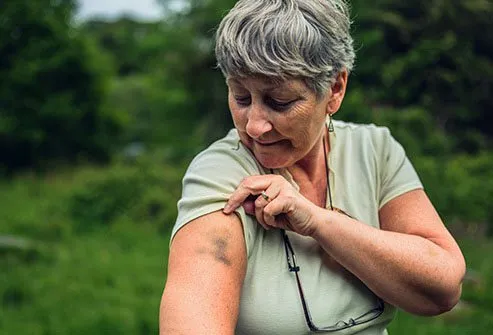
It's normal to get a bruise when you bump into a table or suffer some other injury. Bruises occur when blood vessels under the skin are damaged and leak blood, leading to a red, blue, brown, or black mark. Older people tend to bruise more easily than those who are younger. That's due to skin thinning with age and a loss of fat, both of which make people bruise more easily.
Most bruises are minor injuries and are not a cause for concern. However, sometimes bruises may point to something more serious. Certain medications like blood thinners may increase the risk of bruising. If you develop large bruises, numerous bruises, or start bleeding more than usual, alert your doctor.
Wrinkles

Everyone gets wrinkles as they get older. Wrinkles happen because skin thins with age. Skin also is less able to retain moisture, secretes less oil, and is slow to heal from injury. Repeated facial expressions from muscle contractions helps create and deepen wrinkles. Smoking and sun damage also promote wrinkles.
What can you do about wrinkles? Moisturize regularly and use gentle cleansers on your skin. Do not smoke and quit if you do smoke. Stay out of the sun and use sunscreen when you do go outside. You may ask, what is the best moisturizer for aging skin? What is the best foundation for aging skin? What is the best anti-aging skin care routine? Use products formulated for mature skin or ask your dermatologist if you need recommendations.
Wrinkles happen no matter what. If you want stronger interventions to fight them, see your dermatologist to discuss fillers, Botox, chemical peels, laser resurfacing, and surgery.
Saggy Skin

Saggy skin around the neck and jawline is common with aging. Some people jokingly refer to it as turkey neck. Aging skin loses elasticity, which contributes to the sagging. Fat tends to pool underneath the chin, which also affects the appearance of this area. And neck muscles become weaker, so visible vertical bands start to become visible.
Help preserve the appearance of your neck by staying out of the sun and wearing sunscreen. Moisturize your skin. Do neck, jaw, and throat exercises to keep the muscles in this area strong. If saggy skin is still bothersome, see your dermatologist or plastic surgeon to discuss nonsurgical and surgical options to treat it.
Skin Cancer

Skin cancer is a common condition that increases with aging. By age 70, one in five people in the U.S. will develop skin cancer. The main cause of skin cancer is sun exposure. People who have fair skin, light-colored eyes, and blonde or red hair are at increased risk. Some people develop skin cancer on areas that do not receive sun exposure, like the groin and soles of the feet. That's why scientists think genetics and toxins also play a role in skin cancer development.
Prevent skin cancer by staying out of the sun and wearing sunscreen when you are outside, even on cloudy days. Do not use tanning beds. Doctors treat skin cancer with a variety of different treatments, depending on the size and stage of the lesion.
Skin Problems: Weird Conditions Associated with Aging
This tool does not provide medical advice. See additional information: 
© 1996-2024 WebMD, LLC. All rights reserved.
